| Birds and mammals play crucial, often essential, roles as intermediate or definitive hosts in the complex life cycles of numerous parasites. Many parasites require specific bird or mammal species for their larval stages (intermediate host), where they undergo development and reproduction before infecting a definitive host (often another bird or mammal, but sometimes a different animal entirely) where they reach sexual maturity and complete their life cycle. This intricate relationship can significantly impact the health and population dynamics of both the parasite and its host species, highlighting the interconnectedness of wildlife ecology. 
Birds and mammals play crucial, often complex, roles in the life cycles of a wide variety of parasites. Their involvement isn't simply a matter of being a host; their behaviour, physiology, and interactions with the environment all influence parasite survival, transmission, and evolution.
Birds: - Definitive Hosts: Many parasites require birds as definitive hosts, meaning the parasite reaches sexual maturity and reproduces within the bird. This is common for many species of blood parasites like *Plasmodium* (malaria) and various nematodes (roundworms). Birds can act as reservoirs for zoonotic diseases, meaning they can harbor parasites that can also infect humans.
- Intermediate Hosts: Birds can also serve as intermediate hosts, harboring larval or immature stages of parasites. These parasites may then be passed on to a definitive host – another bird, a mammal, or even a human – through predation, ingestion of infected material (like feces or invertebrates), or other routes. Tapeworms, for example, often use birds as intermediate hosts.
- Vectors: Birds can act as vectors, transporting parasites between different locations. Migratory birds, in particular, play a significant role in spreading parasites across vast geographical distances, impacting the distribution and prevalence of certain diseases. This is crucial in understanding the epidemiology of many parasitic diseases.
- Influence on Parasite Evolution: The co-evolutionary arms race between birds and their parasites leads to adaptations on both sides. Birds have developed immune responses to combat infection, while parasites have evolved strategies to evade these defenses and maximize transmission. The migratory behavior of birds, for instance, can select for parasites with high transmission rates.
Mammals: - Definitive and Intermediate Hosts: Similar to birds, mammals can serve as both definitive and intermediate hosts for a multitude of parasites. This is seen with tapeworms, flukes, and many protozoans. Examples include Toxoplasma gondii (causing toxoplasmosis), which uses cats as definitive hosts and rodents and other mammals as intermediate hosts.
- Reservoir Hosts: Mammals, particularly larger ones, often act as reservoirs for parasites that can infect other species, including humans. This is a major concern for public health, as spillover events from wildlife reservoirs can lead to outbreaks of zoonotic diseases.
- Behavioral Impacts: Mammalian behavior significantly impacts parasite transmission. For example, the social structure of a species, their grooming habits, or their foraging strategies can all influence the spread of parasites.
- Immune Response: The immune system of mammals is constantly battling parasitic infections, leading to a constant evolutionary pressure on parasites to develop new strategies to evade detection and overcome host defenses.
Interconnectedness:
It's important to remember that bird and mammal roles aren't isolated. Many parasite life cycles involve multiple hosts, including both birds and mammals, creating complex ecological interactions. Understanding these intricate relationships is crucial for effective parasite control, disease prediction, and conservation efforts. The disruption of these ecosystems, for instance through habitat loss or climate change, can alter the dynamics of these parasitic relationships, potentially leading to increased disease risk.
Tags: Parasite Parasite Life Cycles  
|
 1,267
1,267  0
0  0
0  3224
3224 